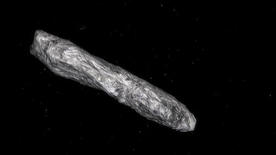
‘Oumuamua, the first known interstellar object to pass through Earth’s solar system, has been called many things: a comet, an asteroid, a cigar-shaped spaceship.
Now it has a new description: Astronomers at Yale and the University of Chicago say it’s a hydrogen iceberg.
A study based on the researchers’ findings has been accepted by the Astrophysical Journal Letters and appears on the preprint website arXiv.
“We developed a theory that explains all of ‘Oumuamua’s weird properties,” said co-author Gregory Laughlin, a professor of astronomy in Yale’s Faculty of Arts and Sciences. “We show that it was likely composed of hydrogen ice. This is a new type of object, but it looks like there may be many more of them showing up, going forward.”
The study’s first author is Darryl Seligman, a former Yale graduate student now at the University of Chicago, who began the research at Yale.
Researchers at the University of Hawaii first discovered ‘Oumuamua in 2017, more than a month after it passed its closest point to the Sun. They named the object after the Hawaiian word for “scout.”
‘Oumuamua is about 900 feet long and traveled through space for millions of years prior to entering the solar system. It has now passed beyond Saturn’s orbit and will travel another 10,000 years before exiting the system.
As ‘Oumuamua hurtled through the inner part of the solar system, astronomers noticed it had several unusual properties. It varied rapidly in brightness, suggesting it was either saucer shaped or cigar shaped. Also, it accelerated in a fashion similar to a comet — yet it showed no evidence of emitting gas or the fine billows of dust normally associated with comets.
Laughlin and Seligman said ‘Oumuamua’s behavior can be explained if it is composed of hydrogen ice.
Although hydrogen is the most common element in the universe it is rarely found in solid form, which requires extremely cold temperatures. Frozen hydrogen does, however, offer a compelling mechanism for acceleration.
“As ‘Oumuamua passed close to the Sun and received its warmth, melting hydrogen would have rapidly boiled off the icy surface,” Laughlin said, “providing the observed acceleration and also winnowing ‘Oumuamua down to its weird, elongated shape — much as a bar of soap becomes a thin sliver after many uses in the shower.”
The study theorizes that iceberg-like objects made of hydrogen can potentially form in the dense cores of molecular clouds that pervade the Milky Way galaxy and give rise to new stars and planetary systems.
“Their presence would be an accurate probe of the conditions in the dark recesses of star-forming clouds and provide a critical new clue for understanding the earliest phases of the still-mysterious processes that generate the birth of stars and their accompanying planets,” Laughlin said.